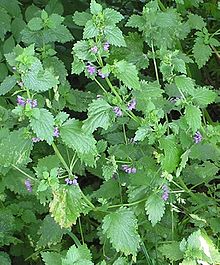Ballota nigra
| Ballota nigra | |
|---|---|
 |
|
| Scientific classification | |
| Kingdom: | Plantae |
| (unranked): | Angiosperms |
| (unranked): | Eudicots |
| (unranked): | Asterids |
| Order: | Lamiales |
| Family: | Lamiaceae |
| Genus: | Ballota |
| Species: | B. nigra |
| Binomial name | |
|
Ballota nigra L. |
|
 |
|
| Range of Ballota nigra | |
| Synonyms | |
|
|
Ballota nigra (black horehound) is a perennial herb of the family Lamiaceae. It is native to the Mediterranean region and to central Asia, and it can be found throughout Europe. It is also naturalized in Argentina, New Zealand, and the Eastern United States. It blooms in the Northern Hemisphere from May to August.
Ballota nigra has a very strong characteristic smell that reminds of mould or humidity, and can be recognised by its clusters of hairy, reddish-purple flowers. It can grow up to 3 feet in height.
It has herbaceous ascending stems, wooden and branched at bottom, covered by down folded hairs. The plant has a taproot system.
Leaves are opposite and decussate, and range from oval-lanceolate to heart-shaped, with crenate or dentate border. Leaves, dark green and usually pubescent, measure 3–8 cm per 2–6 cm, and have 1–3 cm petiole. Upper face is wrinkled, with a net-like vein pattern.
Flowers are organized in verticillasters, subspherical to about one-sided, with 15 to 30 flowers. Each verticillaster consist of two condensed dichasial cymes at axils of normal leaves.
Flower has an actinomorphic calyx (length 9–10 mm, width 7 mm), made up by five sepals fused together in a tube with five teeths; and a labiate corolla of 12–13 mm, ranging from pink to pale purple to withish. The corolla consist of a tube of about 6 mm and two lips; the upper one slightly concave (like a hood) and externally hairy; the lower one glabrous, with two minor lateral lobes and a major central bifid lobe. There are four didynamous stamens, running parallel under the upper lip, with glabrous filaments and yellow anthers. Ovary is superior, with a single white style and a 2-parted stigma.
Below the calyx there are five filiform bracts, 8 mm long.
Each fertilized flower produces a tetrad of black nutlets, cylindrical to ovoid, 2 mm long, partially or fully covered by the calyx. The basal end is flat and attached to the receptacle, while the top end is rounded or pointed.
...
Wikipedia
